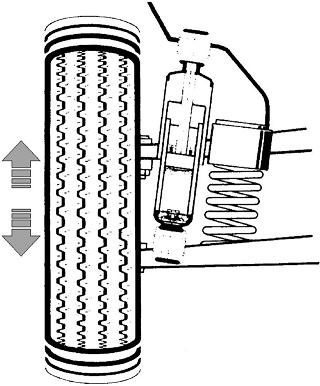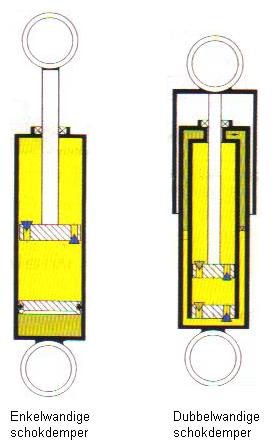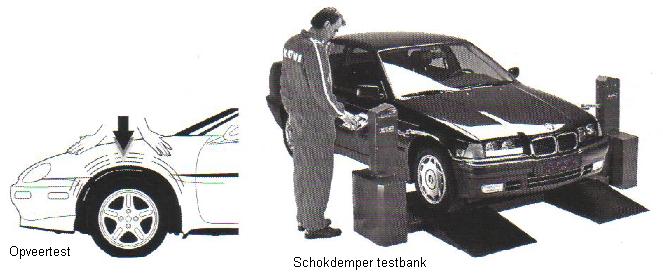Subjects:
- General operation of the shock absorber
- Inward / Outward Stroke
- Consequences of bad shock absorbers
- Check shock absorbers
General operation of the shock absorber:
Shock absorbers increase driving comfort and improve road holding. Their purpose is to absorb the shocks of driving over bumps.
Simple example of how it works: If a thin leaf spring with one end is clamped in a vise, the spring is bent and then released again, the spring will start to vibrate. So each time it distorts with its own frequency. This is the same with a coil spring of a car.
If you drive a wheel over an obstacle on the road, the spring deforms and vibrates. This vibration can be amplified at the next obstacle, so that it bounces again. As the wheel follows the movements of the spring, it will bounce up and down continuously. The purpose of the shock absorbers is to dampen the spring vibrations as quickly as possible. They convert kinetic energy into heat.
A shock absorber does not affect the height of the car. A worn shock absorber will cause poor driving performance, but it won't show when a car is stationary in the parking lot.

Inward / Outward Stroke:
Inward Stroke:
On the inward stroke of the shock absorber, the piston moves downwards relative to the cylinder. The oil then flows under the piston via the bores to the space above the piston. The pressure on the oil is equal under and above the piston. To compensate for the volume occupied by the piston rod, oil flows below the piston through the bottom valve to the reservoir tube. The inward stroke should be smooth; it must be prevented that the car is “lifted” in the event of a bump in the road surface because the inward stroke would be heavy. The damping is obtained by the outward stroke.
Outward Stroke:
On the outward stroke, the piston moves upwards relative to the cylinder. A certain pressure is exerted on the oil above the piston, so that this oil flows through bores to the space below the piston. The resistance encountered by the oil provides the force during the outward movements of the shock absorber. Oil flows from the reservoir tube to the space below the piston through the bottom valve to compensate for the volume occupied by the piston rod. The force required in the outward stroke is greater than in the inward stroke.
With a loose shock absorber it will be noticeable that it can be easily pressed in, but difficult to pull out again. If the input and output movements were both smooth, that would mean that the damper is worn out.

Consequences of bad shock absorbers:
- The braking distance becomes longer. If the wheel bounces, it loses contact with the road, resulting in an interrupted brake track.
- In a bend, it is the friction between tire and road surface that keeps the car on the road. With bad shock absorbers, a car will skid much faster in a bend. The road holding is also less good on a straight road.
- The controls are less precise.
- The carcass of the tire is overloaded, which can even lead to a blowout.
- Worn shock absorbers also cause typical tire wear, where the tires have large wear spots in random places and sufficient profile in other places.
Checking shock absorbers:
Spring test:
The global operation of shock absorbers can be checked in the following way:
- Grab a firm part of the fender or the like (which will not dent under force). Move it up and down in a smooth motion so that the car bounces in and out firmly.
- Release the car after a few bounces and bounces.
- The car may not exceed a maximum of 2x; in-out and in-out again.
- If the car continues to bounce in and out several times until the body comes to a standstill, the shock absorber is worn out.
- If the car can be sprung very far in and out so that the wheel comes off the ground, the shock absorber no longer offers any damping at all. What happens now is that the spring can bounce in and out as much as possible without the springing movement being damped. The maximum suspension travel is reached in a short period of time, causing the body to rise and fall further and further. In that case, the wheel can come off the ground during the rebounding movement. The latter is very dangerous. This can also happen while driving. The risk of an accident is greatly increased when driving on poor road surfaces.
Shock absorber test bench:
The manual rebound test is not entirely reliable. A better way to test shock absorbers is with a shock absorber test bench. From a certain height, the road plates are unlocked, causing the plates to fall down a bit (about 20 cm). Based on the results of the car's drag, the computer can calculate per wheel to what extent the shock absorber is worn.

